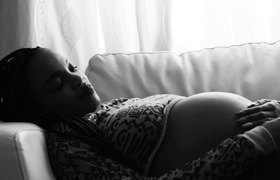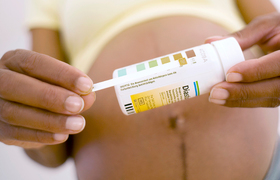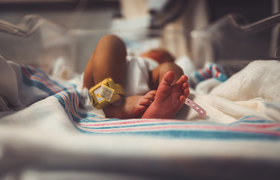UCT professor highlights dangers of iron deficiency disorder during pregnancy
17 August 2021 | Story Niémah Davids. Photo Supplied. Read time 6 min.
The Division of Haematology at the University of Cape Town (UCT) and Groote Schuur Hospital (GSH) has embarked on a massive international campaign to drive awareness on the dangers of untreated iron deficiency disorder during pregnancy. The drive seeks to highlight the importance of a pre‑pregnancy diagnosis, to initiate treatment and to avoid the enormous post‑birth ramifications for the unborn baby.
The head of the division, Professor Vernon Louw, said iron deficiency disorder is one of the most common health challenges among women in South Africa; it’s said to affect approximately 50% of woman nationally. In the Western Cape, 57% of women are iron deficient, many of whom are adolescents and young adults.
An iron deficiency, Professor Louw explained, occurs when the body holds too little iron, usually as a result of blood loss (mainly from menstruation or previous pregnancies), or from poor eating habits, especially in people who eat too little red meat. This results in low levels of haemoglobin (the protein found in red blood cells that carries oxygen throughout the body). With too little iron in the bloodstream, the body will not receive the amount of oxygen it needs. According to Louw, several high‑risk factors are associated with iron deficiency disorder during pregnancy, and are especially dangerous for the unborn baby.
“We know now that if a mother is iron deficient during pregnancy and does not receive an iron replacement, it poses huge neurological and cognitive development risks for the baby post‑birth.”
“We know now that if a mother is iron deficient during pregnancy and does not receive an iron replacement, it poses huge neurological and cognitive development risks for the baby post‑birth,” he said.
Startling complications
He said intrauterine growth retardation, a high risk of pre-term birth, and trouble breastfeeding are some of the startling complications both mother and baby may face. In addition, following birth, babies may struggle to bond with their mothers, and are likely to develop significant neurocognitive impairments later in life.
It gets worse as the child gets older. By the age of five, their communication and interpersonal skills will differ compared to children born to mothers with healthy iron levels, Louw said. They also have difficulty channelling their emotions, which could lead to behavioural issues. Once they reach school level, learning literacy, numeracy and problem‑solving competencies are challenging, and in‑class concentration is not as simple for them as for their peers.
Regrettably, these challenges persist into the adolescent stage; children born to mothers with low iron may also struggle with aggression, anxiety and depression. By the age of 25 these struggles will have become consistent, and the probability of developing autism or schizophrenia is also high.
On a mission
With the right awareness, Louw said, it’s possible to turn the tide and change the trajectory of thousands of young children’s lives.
“I am on such a huge mission because it’s so easy to treat an iron deficiency – it costs next to nothing. In fact, it’s one of the cheapest interventions around, and will help save the brainpower of our future generations,” he said.
Part of Louw’s training mission also includes training obstetricians and gynaecologists on the importance of testing patients’ iron levels. He adopted this approach after discovering that too many obstetricians and gynaecologists only test patients for anaemia – a condition in which the blood lacks adequate healthy red blood cells, as a result of an untreated iron deficiency – and not for iron deficiency disorder itself. The response to training has been overwhelmingly positive.
“It’s important to note that an iron deficiency, even in the absence of anaemia, has significant ramifications for the baby.”
Interestingly, patients with iron deficiency disorder (before anaemia develops) and those with anaemia present with similar symptoms (fatigue, irritability, hair loss and brittle nails). As a result, clinicians are often thrown off track regarding the real health challenge. But through testing pregnant women for anaemia only, Louw said, approximately 47% of patients with iron deficiency disorder slip through the cracks.
“It’s important to note that an iron deficiency, even in the absence of anaemia, has significant ramifications for the baby,” he said.
“When nobody checks if you’re iron deficient during pregnancy, and they only check if you’re anaemic, they will miss the iron deficiency. And the consequences are huge.”
Since the start of the year, Louw has convened many local and international lectures to educate scientists and clinicians on the dangers of iron deficiency disorder during pregnancy. Slowly, he said, the world is starting to “pay attention”.
“We need to bring the message across, and I’m taking every opportunity I get to talk about it. Treatment is a no‑brainer. If you treat the mother during pregnancy, these long‑term risks [for] the unborn child [are] completely preventable,” he said.
Lobbying government
Louw said that alongside training clinicians, his second but equally important focus is to lobby government to do more about iron deficiency awareness at community level.
“It will make such a huge difference, for a relatively small cost.”
Awareness starts with education and effective communication. He is encouraging provincial and national government to get on board, and to adopt strategies at community healthcare level that focus on testing and treatment.
“It will make such a huge difference, for a relatively small cost,” he said.
“But the results will be far‑reaching. We’ll have a population of young people who are both intellectually and socially stronger, and who have a much greater chance at success. That’s what we need to build a better South Africa.”
 This work is licensed under a Creative Commons Attribution-NoDerivatives 4.0 International License.
This work is licensed under a Creative Commons Attribution-NoDerivatives 4.0 International License.
Please view the republishing articles page for more information.










